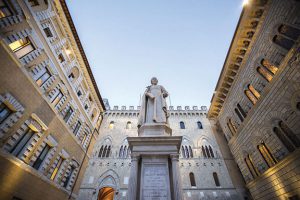Bloomberg
Banca Monte dei Paschi di Siena SpA may seek a capital injection of about $4 billion, in a reassessment of the cost to stabilise the state-owned lender.
The amount, which could be a billion euros more than estimated in December, is now seen by the treasury as necessary to comply with the bank-specific capital regulations set by the European Central Bank.
The capital gap has widened after management reviewed a restructuring plan necessary following the failure of the Italian government last year to sell the Siena-based lender to UniCredit SpA. A final assessment on the capital increase hasn’t been taken yet as it depends on the cost of the restructuring and the total amount of job cuts it
involves, the people said.
In a statement, Monte Paschi said that the report of a potential 3.5-billion-euro capital increase has “no basis in any initiative launched by the bank.â€
Monte Paschi, the world’s oldest bank, continues to be a burden on Italian state more than a decade after it was first bailed out. The growing shortfall makes Prime Minister Mario Draghi’s task even harder, and comes at a time when lender’s management is in turmoil following the sacking of former chief executive Guido Bastianini.
The management changes could delay decisions related to a capital increase including its final size, two of the people said.
Earlier this month the government ousted Bastianini, who had been appointed under a previous administration with the support of the populist Five Star Movement, amid differences on strategy and management. Draghi replaced him with veteran banker Luigi Lovaglio.
The new chief will need time to assess the bank’s situation and review one of the most complicated outlooks in the
industry.
The viability of Monte Paschi as a standalone bank has long been in doubt, in particular as the approval of the European Union for the state aid it has received make consistent profitability difficult.
The government had been obliged to exit its stake in the bank by the end of last year, and is now negotiating a new deadline.
“Member states have to comply with state aid commitments and it is for them to propose ways to fulfil such commitments,†a spokeswoman for the European Commission said in response to a question on the Bloomberg report. “It is therefore up to Italy to decide and propose ways on how to exit the MPS ownership taking into consideration the 2017 State aid commitments.â€
The biggest point of contention leading to the collapse of talks with UniCredit was the amount of capital that Monte Paschi needed before being transferred to UniCredit. UniCredit Chief Executive Officer Andrea Orcel had argued it needed about 7 billion euros to restore Monte Paschi’s capital buffers and cover the costs of job exits. That was about three times higher than the initial estimate of the Treasury.
 The Gulf Time Newspaper One of the finest business newspapers in the UAE brought to you by our professional writers and editors.
The Gulf Time Newspaper One of the finest business newspapers in the UAE brought to you by our professional writers and editors.
